Magic has been with mankind since the dawn of time. The first sources on witchcraft date back to ancient Mesopotamia and Babylonia. However, the period when magical writing became particularly popular was during the Middle Ages.
Magic was viewed very differently in medieval Europe. Initially, its image was not particularly negative and resulted from the synthesis of the achievements of ancient cultures, pagan beliefs and Christianity. The end of this epoch is also the beginning of the church's struggle against all manifestations of magical practices. Nevertheless, throughout the Middle Ages, a huge number of magical manuscripts appeared in Europe, which we now call grimoires.
Read also:Magic, drunkenness and the forest flowing with the blood of virgins. How did the ancient Romans enter the new year?
Form and content
The word "grimoire" comes from the French word "grammaire". In eighteenth-century France, this term was used to describe all works written in Latin, although in colloquial speech "grammaire" meant "a book on magic." According to the common opinion at the time, secret knowledge had to be difficult to access, so what was written in less and less popular Latin had to be about magic . For the students of the secret arts, however, it was important not only what the grimoire contained, but also how and what it was made of. The beginning of the Middle Ages is associated with the debut of a new writing material - parchment. However, not every parchment was good for perpetuating magical knowledge. Often times, medieval manuscripts had to be written on the skin of an animal that had not yet reached sexual maturity.
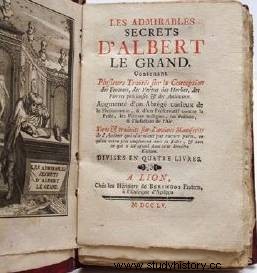
Title page of "Le Grand Albert" - 1755 edition
An animal amniotic bag was also used to produce the "magic" parchment . It happened that a magician had to kill an animal himself to make sure that the leather used to make the book would not be "desecrated" by anyone. It was also important what the magic formulas were written down. More than once the manuscripts were written with animal blood or blessed ink.
Read also:Was Queen Jadwiga practicing black magic?
From Zarathustra to King Solomon
In medieval Europe, the image of magic was shaped by the achievements of ancient civilizations in the Near East, Greece, Rome and Byzantium. Over the centuries, in each of these cultures, there have appeared figures considered to be great magicians and connoisseurs. Among the entire pantheon of legendary wizards, we can mention, for example:Zarathustra, Henoh, Kyranides, Simon the Magician or Hermes Trismegistus. To make magic books authentic, their authors associated the names of their works with one of these ancient characters . King Solomon was the most popular magician of the Middle Ages. The thirteenth-century theologian and philosopher Albert the Great reported that there were as many as five magical books associated with his figure. The first is the so-called "Testament of Solomon."
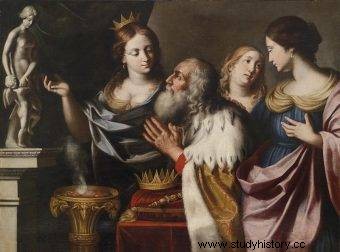
King Solomon with his wife
It describes the struggle of the king of Israel with the demons who hindered the construction of the temple in Jerusalem. According to her records, the archangel Michael was to give Solomon a ring with the power to control evil spirits. Solomon's Testament was not taken as a biblical parable, but rather an occult textbook. One copy of this title had instructions for magical practices noted in the margins.
The most famous books related to the figure of Solomon, however, were:"Almandal", "Ars Notoria" and "Clavicula Salomonis" also known as "The Greater Key of Solomon."
These titles were already full-fledged grimoires and they described step by step the ways of performing magic rituals or summoning demons. In addition, they contained love spells, allowed to cast evil spells, become invisible, and learn about medieval liberal arts.
Also read:How many people REALLY died in witchhunts?
God a candle ...
Up to a certain point, the Middle Ages were a period in which the exploration of secret knowledge was treated rather leniently. The Church was also so tolerant that it modified the customs popular among pagan societies and incorporated them into Christian practices. A similar process also applied to magic books and spells. The Old English manuscript "Lacnunga" contained both pagan incantations to Odin and Christian prayers.
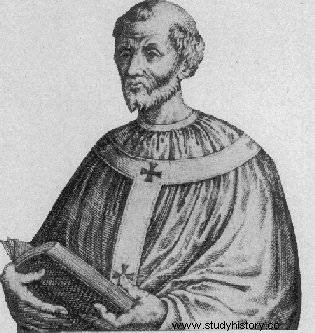
Pope Alexander IV even reminded inquisitors not to investigate witchcraft
The book "Pseudo-Apuleius Herbarium", which deals with herbs, began with the prayer of Our Father, but in the original there was an invocation to "Holy Mother Earth". In the seventh century, St. Isidore of Seville divided magic that was less dangerous for the church, i.e. witchcraft and demonic magic . In 1258, Pope Alexander IV even reminded the inquisitors not to investigate the former. Even considering the existence of demonic magic, until the end of the 13th century, witchcraft trials were rather incidental.
Moreover, those who had the greatest contact with the works of magic at that time were priests and religious. The monastic libraries were full of all kinds of grimoires, and the monks did not restrain their diligent study. Another place where you could study magic books was in universities. The university atmosphere and open minds of medieval students provoked the study of all kinds of knowledge, including the secret.
Arab power
The conquest of the Iberian Peninsula by the Saracens and the Crusades made access to the achievements of Arab culture much easier in the Middle Ages than in the past. Therefore, all those who were looking for information on magic could go to Arab libraries in Toledo or Seville. In the 13th century, there was even a saying in Europe that:"liberal sciences are studied in Paris, law in Bologna, medicine in Salerno, and demons are taught in Toledo" . In line with this, one of the most famous medieval grimoires was created in Spain - the "Picatrix".
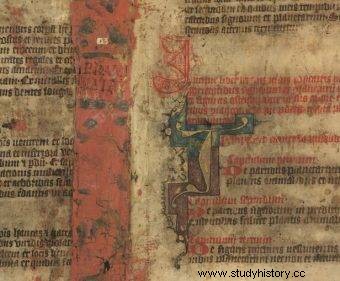
The photo shows a fragment of a Picatrix stored in the Slovak National Library
Its true creator is unknown, but it says that it is a synthesis of over 224 Arabic magic books. The "Picatrix" was written in Arabic in the 12th century, but was translated into Latin in the following century by order of King Alfonso the Wise of Castile. Contrary to works attributed to Solomon, "Picatrix" focused on astral magic, the art of creating amulets and talismans and reading zodiac signs . Another example of Middle Eastern influence on the perception of magic is the birth of Kabbalah, a mystical Jewish philosophy.
It was created on the basis of books written between the 11th and 13th centuries in Italy, Germany and Spain. The most important of them were:"Book of the Pious", "Book of Brightness" and "Book of Light". In addition to philosophical and religious themes, they also contained references to onejromancy, palmistry and the art of summoning demons.
Read also:Chess. Demonic entertainment or an oriental game of symbols?
Burn them all
Between the 16th and 15th centuries, the church drastically changed its approach to the magical arts. In 1326, Pope John XXII issued the bull "Super illius specula", in which magic becomes a heretical practice.
In turn, in 1376, Nicolau Eymerich, an Aragonese Dominican and theologian, wrote "Directorium Inquisitorium", sort of a textbook for inquisitors in which magic is heavily criticized.
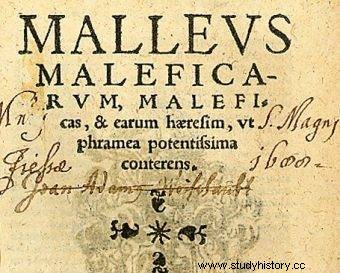
"Hammer for witches" - seventh edition cover from 1520
Similar texts began to appear in Europe more and more often, and finally in 1486 Heinrich Kramer published the famous "Malleus maleficarum", that is, " Hammer of the Witches ". Shortly thereafter, piles began to burn all over Europe, on which not only the books forbidden by the church were burning, but also witches accused of practicing magic.
Read also: The witch hunt or how men hated women
